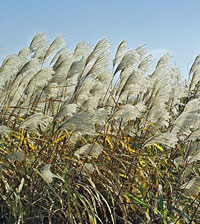| Jan 04, 2013 | |
Delayed flowering results in up to 50 percent increase in biofuel crop yield |
|
| (Nanowerk News) Researchers working on the biofuel crop Miscanthus sacchariflorus, commonly known as Asian Elephant Grass, have shown that delaying flowering in the plant can result in a 50% growth increase. | |
| The discovery could have important implications for biofuel production, leading to higher yields and increased productivity from the crop - helping increase its commercial viability and reduce carbon emission for energy and fuel production. | |
 Miscanthus sacchariflorus Using non-food crops such as the fast-growing M. sacchariflorus to make biofuels is an important avenue of research, as the world's population is predicted to rise to nine billion by 2050. Food productivity will have to rise by 70% to meet demand, raising concerns over the use of food crops for bioenergy. Non-edible plants are therefore an attractive alternative if they can be grown in a way that does not compete with food. The team from the Institute of Biological, Environmental and Rural Sciences in Aberystwyth University grew six varieties of M. sacchariflorus, representing a range of latitudes from their origin in Asia. The use of different temperature and light treatments showed that delaying flowering by an average of 61 days resulted in an average growth increase of 52%. "We need to maximise outputs and minimise inputs in order to make biofuels and bioenergy sustainable," says Dr Elaine Jensen of Aberystwyth University. "Day lengths vary across different latitudes, so this research helps us understand what kind of impact that could have on yield". As well as demonstrating for the first time that M. sacchariflorus plants flower more slowly, but with increased biomass, when daylight hours exceed 15 hours in a 24 hour period, the research also provided key information regarding what day length and temperature treatments are best used to synchronise flowering between different Miscanthus species and types. |
|
| "We are breeding new Miscanthus varieties that will be optimised for growth in different environments, but making crosses between some plants has been problematic. ", says Dr Clifton-Brown, Miscanthus breeder at Aberystwyth University, "This research has provided fundamental knowledge on flowering synchronisation so that we can breed new, high performance varieties." | |
| The findings, published in the Journal of Experimental Botany ("Flowering induction in the bioenergy grass Miscanthus sacchariflorus is a quantitative short-day response, whilst delayed flowering under long days increases biomass accumulation"), also showed that flowering responses in Miscanthus sacchariflorus resembled those of its close relative, Sorghum, another important energy crop. | |
| Research by the same group in Aberystwyth has recently highlighted similarities between the Sorghum and Miscanthus genomes ("High Resolution Genetic Mapping by Genome Sequencing Reveals Genome Duplication and Tetraploid Genetic Structure of the Diploid Miscanthus sinensis"), meaning that advances in understanding the genetic mechanisms underlying flowering in one crop will likely promote understanding in its counterpart. | |
| This research is part of a four-year BBSRC-funded project looking at the impact of flowering time on biomass quality and quantity in Miscanthus. |
| Source: BBSRC |
